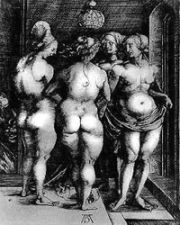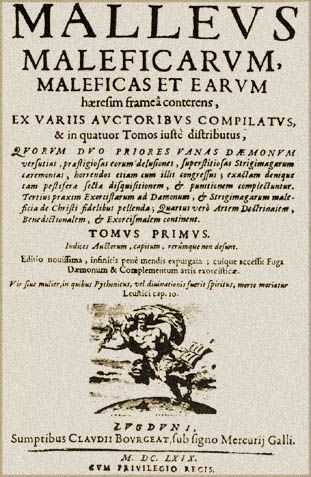
Publisher:
Bonnie King
CONTACT:
Newsroom@Salem-news.com
Advertising:
Adsales@Salem-news.com

~Truth~
~Justice~
~Peace~
TJP
Dec-18-2008 23:00

 TweetFollow @OregonNews
TweetFollow @OregonNews
How Witches Evolved
Kenneth G. Ramey Salem-News.comTrials of persons who claimed to be witches simply confirmed that they possessed what they always claimed they had, power.
 The Malleus Maleficarum (Latin for “The Hammer of Witches”, or “Hexenhammer” in German) is one of the most famous medieval treatises on witches. Courtesy: neptun8.ru |
(PASO ROBLES, Calif.) - Rev. Montague Summers who wrote the Introductions to the MALLEUS MALEFICARUM, spoke of witches as late as the 1920s as if they truly existed, nor have I read anywhere that the Church has reversed its position on the matter. Summers also defended the Inquisition's methods as necessary to keep the Catholic flock under control.
 Many Evangelists claim their followers alone are real-Christians, and that “intelligent people” who question what they say is the word of God, “are evil." They use politics to achieve their end by appealing to the Religious Right of the Republican Party’s base composed of Conservative die-hard traditionalists.
Many Evangelists claim their followers alone are real-Christians, and that “intelligent people” who question what they say is the word of God, “are evil." They use politics to achieve their end by appealing to the Religious Right of the Republican Party’s base composed of Conservative die-hard traditionalists.
Chris Hedges, in his book AMERICAN FASCISTS, THE CHRISTIAN RIGHT AND ITS WAR ON AMERICA [Free Press, Division of Simon &Schuster, Inc., New York. © 2006. - available at Amazon.com] describes American Evangelists as using propaganda to instill in followers the belief that Christian is a designation that applies only to those who accept in silence what Evangelists say, and will do as they are told.
Communities change over time, and Christianity is no exception, but change occurs slowly. From its beginning Christianity denied the witch concept. It’s Canon Episcopi proscribed superstition generally, and witches in particular, by denying that witches met in covens presided over by an “evil-deity.”
Christian philosophy accepted just one Deity, the Christian God of all Nations, and refused to admit to any competition. As late as the Eleventh Century, the Church still denied beliefs commonly-held that witches existed when Burchard, Bishop of Worms [1006-1025] wrote that "People who believed in witches cavalcades . . . were returning to paganism and were accepting as real what were, in fact, no more than subtleties and illusions of the Devil."
After establishing its Church, Christians were persecuted for three hundred years as one of several competing religions before it became the religious arm of Empire in 312 A.D. and gained religious ascendancy. Rome achieved its dubious Primacy over Constantinople in the 7th Century by devious means that caused a schism between the Orthodox and Roman hierarchies that has yet to be resolved. And it is significant that witch hunts didn’t catch on in Orthodox countries, perhaps because the Islamic thrust into Eastern Europe and Spain were nearly co-incident in time.

In 312 A.D. Constantine, then a Pagan was about to fight the Battle of Milvian Bridge to determine who would be Emperor of the Empire. His adversary, Maxentius, was presumed to possess considerable magic on his side, and Constantine needed a magic greater than Maxentius’ if he hoped to defeat his adversary. Christians offered him a banner with CONQUER WITH THIS emblazoned upon it that Constantine carried into battle, and won. Constantine became emperor, converted to Christianity over which he exercised control by Caesaropapism, a political system in which the head of state has authority over the church and all religious matters. Caesaropapism operated in the Roman and Byzantine empires under Constantine, and in pre-revolutionary Russia that considers itself the Third Rome after Constantinople.
In 313 A.D. Constantine issued his Edict of Milan allowing freedom of worship to all religions, and freed Christians from future persecution. In 325 A.D. Constantine settled the previously disputed meaning of the Trinity among leaders of the Church via The Nicene Creed that is respected and recited in Christian Churches yet today. Until his death, Constantine was the voice of Christianity, and his legacy continued to influence the humble conduct of the Church up to the time of the Renaissance [c.1350-1700] when the opulence of the Church exploded with riches obtained from expanding trade routes and the New World. New wealth changed the habits of the Church’s rational religiosity, and contributed to its corruption that the Humanist element of the priesthood abjured.
Humanists were not reformists in the Protestant sense of the word, but intelligent priests who sensed the Church’s drift away from the purity of its beginnings. The Church noted the increasing dissent and modified the Canon Episcopi to acknowledge as real what before were “in fact subtleties and illusions of the Devil” [per Burchard]. It contrived to defeat the “evil” of disaffection by referring to individuals of apostate and heretic disposition as ”witches” who worshipped the Devil and his disruptive [anti-Christ] intent at imaginary covens.
In the late 1400s, the Dominican Friars, Kramer and Sprenger of Germany authored the Malleus Malificarum [The Witches Hammer] to which they lent their incredible imaginations, and in 1486 Pope Innocent VIII sanctioned it, contrary to his better judgment. The Malleus became the legal-code of the Catholic Church to arrest, convict and sentence, even unto death, the disillusioned, not of the faith, but of Church Dogma. Inquisitors were given every latitude in the interpretation and use of the Malleus Malificarum and exercised its power with the utmost sense of purpose; the result was dreadful. In 1511 the Humanist Erasmus wrote his In Praise of Folly, criticizing the Church. His essay was said to be the egg Martin Luther hatched in 1525, lending weight, if not Luther’s approval, to the movement for reform, and the Reformation took off in all it gory, Lutherans and Calvinists being the severest Protestant practitioners.
Spain’s Inquisition was used in the New World too, but to a lesser extent. Being somewhat isolated in its peninsula, and concerned with its New World territories, Spain’s Inquisitors were first to acknowledge the psychological aspect of the so-called “craft,” took pity on victims, and backed off, but not before some of its Inquisitors earned for themselves highly repugnant reputations for their severity.
Rome responded to the Reformation with a Counter-Reformation by deciding the Roman-Order should be everlasting according to its dictate, and required Catholics to pledge their allegiance, via the Edict of Faith, to the reality of witches under pain of ex- communication and the charge of "accessory to a crime against religion;" the penalty for refusal could be death. Members of one’s own family, Familiars, were expected to report any and all deviants from the faith to the Holy Office of the Inquisition for adjudication. Protestants adopted the Malleus Malificarum and used the same methods against Catholic defectors who subsequently had a change of heart. Together, Catholic and Protestants contributed to the humiliation and awful deaths of millions of so-called witches before the dreadful annihilation ended with enlightenment in the 18th Century.
The definition of so-called witches, and those who believed themselves to be witches, overlapped creating a blur of confusion. Defectors were punished because their rationality did not accept Rome’s prescription for the perfect community, a City of God based on the collective emotionalism of a homogenized whole subject to the authority of Rome’s Apostolic Oneness. And, they died because they preferred an Order other than Catholic that Protestants considered an improper subordination of man's intellect to an enforced common-morality. The awful tactics and gruesome reality of both Inquisitions ultimately resulted in the Second schism that might have been avoided had the Catholic Doctrine of Papal-Infallibility not refuted its faults.
Witches are not real, and the Church knows it if the Pope truly is the Vicar of Christ, and Jesus is the omnipotent God, but neither presumption is true. The Church sought to control its Holy Spirit [it's Congregation] by tyrannously controlling its members. Witch trials were held to eliminate the sentiment of dissenters, and to impress on witnesses of Autos da Fe the advisability of toeing the proper line of religious thought. Still, things are not always as they seem. Whereas so-called witches were victims of communal and religious persecution, trials involving self-proclaimed witches produced a curious form of vindication.
Trials of persons who claimed to be witches simply confirmed that they possessed what they always claimed they had, power. Moreover, it was a power not under the control of the Church and which psychologically affected people who knew them, or of them, even after they had been killed. Witches are symbols of otherness stimulated by man's ignorant imagination that plays upon the psyche, not things.
The challenge of Life is of distinction. If man is to live better, he must live honestly. There is no better way to meet the challenge than by educating oneself to the pitfalls of enculturation. Truth alone can resist the force of our givens, and the habits of our minds. Anything less is faith in the opinion of others whose purpose, too often, is to play upon human susceptibility for their own benefit.
Is there another side to the issue? Of course; it is mystery with a purpose. There is beauty in emotion when properly stimulated. Who would forsake the mystery of Santa Claus and willingly miss the experience of wonder that possesses a child who, when finally truth is revealed, accepts it with grace, not resentment.
A Catholic once told me, "I don't believe everything the priests say, but I do love the ceremony;” the Service is a traditional and beautiful ceremony, and she feels better for having experienced it. Amen.
 Kenneth G. Ramey was a 79-year old "writer without a Website" who is generating excellent, provocative articles on the subject of religion and world affairs. We are pleased that Ken's "lone wolf" presence as a writer in the world has been replaced by a spot on our team of writers at Salem-News.com. Raised in Minnesota and California during the dark years of the Great American Depression, Ken is well suited to talk about the powerful forces in the world that give all of us hope and tragedy and everything in between. You can write to Ken at: kgramey@sbcglobal.net
Kenneth G. Ramey was a 79-year old "writer without a Website" who is generating excellent, provocative articles on the subject of religion and world affairs. We are pleased that Ken's "lone wolf" presence as a writer in the world has been replaced by a spot on our team of writers at Salem-News.com. Raised in Minnesota and California during the dark years of the Great American Depression, Ken is well suited to talk about the powerful forces in the world that give all of us hope and tragedy and everything in between. You can write to Ken at: kgramey@sbcglobal.net
Articles for December 17, 2008 | Articles for December 18, 2008 | Articles for December 19, 2008



Salem-News.com:

googlec507860f6901db00.html
Terms of Service | Privacy Policy
All comments and messages are approved by people and self promotional links or unacceptable comments are denied.
Chris December 20, 2008 9:42 am (Pacific time)
I want to also thank you for a well written and thought provoking article.
Vic December 19, 2008 8:00 am (Pacific time)
Thank you Ken for another insightful article !
[Return to Top]©2025 Salem-News.com. All opinions expressed in this article are those of the author and do not necessarily reflect those of Salem-News.com.